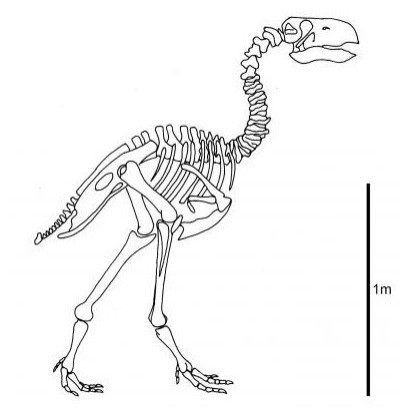50-Million-Year-Old Man-Eating Terror Bird 'was 'Vegetarian'
Two-metre-tall Gastornis bird just an overgrown chicken, not the king of the primordial jungle as first believed

A man-eating, giant "terror bird" that lived between 55 and 40 million years ago as top predator of the land ago was actually a vegetarian, researchers have said.
The flightless Gastornis bird stood at around two metres tall and had an enormous beak.
From its size and appearance, it has long been thought that it was a ruthless carnivore that ruled Europe and feasted on mammals.
Thomas Tütken, from the University of Bonn, said: "The terror bird was thought to have used its huge beak to grab and break the neck of its prey, which is supported by biomechanical modelling of its bite force
"It lived after the dinosaurs became extinct and at a time when mammals were at an early stage of evolution and relatively small; thus, the terror bird was thought to have been a top predator at that time on land."
However, the research team from Germany now think the terror bird was just an overgrown chicken.
By analysing fossilised remains of asGastornis from a former brown coal mine, they found the bird was probably not a meat-eater.
They looked at the calcium isotope composition of the bird's fossilised bones, meaning they were able to establish what proportions of its diet were plant and animal.

The calcium isotope becomes 'lighter' as it passes through the food chain. By comparing the bird's results to those of carnivorous and herbivorous dinosaurs and mammals, they found its diet was much closerr to those of vegetarian animals.
US palaeontologist also recently found evidence to back up the new theory that the terror bird was not a meat-eating menace.
Researchers found footprints believed to have belonged to a species of the terror bird in North America. The imprints showed no sharp claws, which would have been evolved if the creature was a predator.
They also said that the size of the Gastornis would have made it difficult to move fast, adding to difficulties if it had to hunt down its food.
The University of Bonn team now plans to conduct further analysis on the terror bird to better pinpoint its diet.
"Tooth enamel preserves original geochemical signatures much better than bone, but since Gastornis didn't have any teeth, we've had to work with their bones to do our calcium isotope assay," Tütken said.
"Because calcium is a major proportion of bone - around 40% by weight - its composition is unlikely to have been affected much by fossilisation. However, we want to be absolutely confident in our findings by analysing known herbivores and carnivores using fossilised bone from the same site and the same time period."
© Copyright IBTimes 2025. All rights reserved.






















